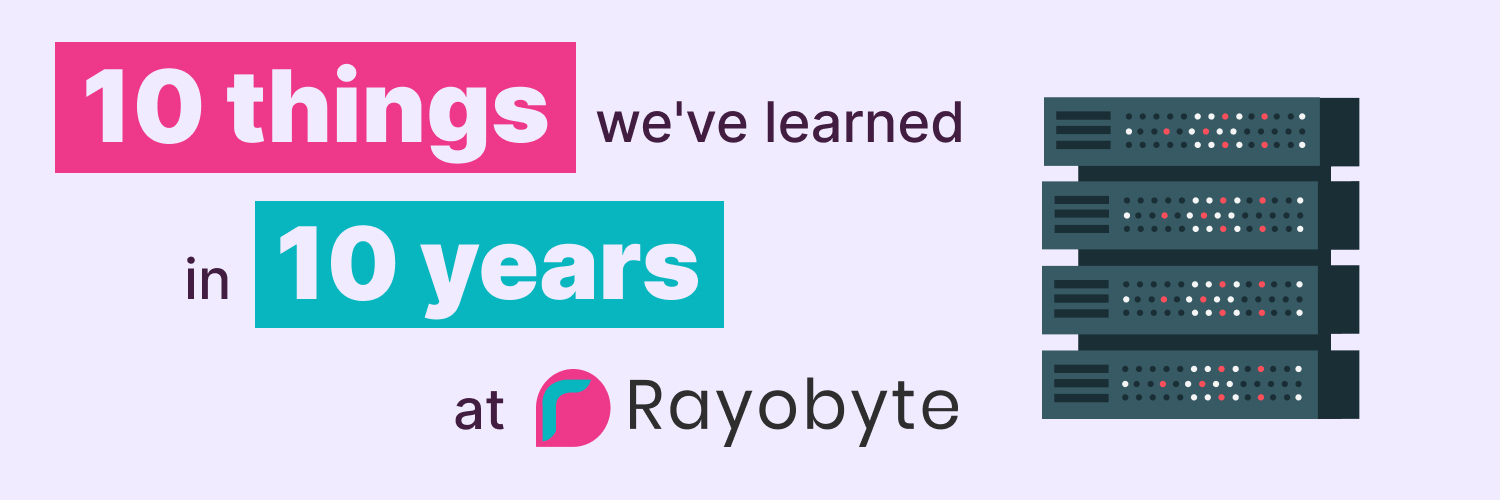Ruby Scraping (How To Do It And Why It’s Useful)
As a visionary business person, you might already be aware of all the benefits web scraping brings to the table. It’s one of the most useful sources of information to conduct valuable research that helps improve business operations and escalate a company. However, performing this task manually is time-consuming. Data moves fast on the internet, and having a tool to extract it in real-time is always useful.
Building your own scraping tool is the best way to ensure your data extraction solution is tailor-made. You can configure it according to your business needs, which will offer you better results than other options. Yet, we understand you might hit a wall when getting to the coding part. Which programming language should you use? There are a lot of options to start developing your web scraper, and each of them has its own set of advantages and disadvantages.
This guide is intended to explore the benefits of web scraping with Ruby. If you’re unfamiliar with this scripting language, read on.
Web Scraping With Ruby 101

If you’ve decided to create your very own scraping tool, you have numerous programming language and framework alternatives. One of them is Ruby, not to be confused with Ruby on Rails (RoR). But before we move on to our Ruby tutorial and learn how to scrape the web with Ruby, let’s break down what it is.
What is Ruby?
Created by Yukihiro Matsumoto in the 1990s, Ruby is an interpreted, object-oriented programming language. It was written in C# language, and it’s able to support numerous platforms. Ruby was created with simplicity as a priority, with the primary goal to create a sensible buffer between programmers and their machines.
This open-source scripting language is a widely popular choice among developers and data scientists because:
- It uses dynamic typing
- It’s more similar to spoken language than other alternatives
- It has a simple and powerful script
- It allows for the fast creation of applications
- It’s easy to maintain and scale
- It’s constantly being improved
- It has additional libraries to extend its capabilities
Ruby uses a similar syntax to other programming languages like Perl or Python, where class and method definitions are signaled by specific keywords, and both keywords and braces can define code blocks. Yet, Ruby is easier to understand due to its dynamic typing. This scripting language uses garbage collection and just-in-time compilation, and it supports a plethora of programming paradigms. It offers modules for Ruby parsing JSON, Ruby CSV parse, and Ruby HTML parse.
Although Ruby is easy to learn, has a very liberal license, and offers numerous advantages to developers, it also has some drawbacks. While using it, you could encounter some performance issues and have a hard time dealing with its threading model. Ruby doesn’t use native threads. Instead, they are simulated in the virtual machine. This language’s green threads are known for causing scheduling events.
Ruby or Ruby on Rails: What’s the difference?
When talking about Ruby and Ruby on Rails, people often assume they’re the same thing. However, they’re not interchangeable. While Ruby is a popular programming language, RoR is a server-side open-source software written in Ruby. It’s typically used to build web applications.
In other words, Rails is a framework that’s useful in creating websites and applications using Ruby, and the combination of both is called Ruby on Rails. Here’s what’s similar between them:
- They’re both open-source — which means they’re both free to use and distribute. Users from all over the world can contribute to their development and enhancement.
- They have the same underlying philosophy — both the coding language and the framework are meant to be easy and fun to use. The creator of Ruby wanted to build a simple and enjoyable programming language, and RoR holds up to that philosophy.
- They both have a simple and consistent syntax — Which closely mirrors natural spoken language to increase efficiency and avoid repetitive coding.
RoR is based on model view controller (MVC) architecture, which separates data structures from the UI (User Interface) design and provides various views of data. It’s made up of three parts:
- Modal — responsible for maintaining data
- View — responsible for displaying data
- Controller — responsible for administering interactions between Modal and View
This software can also be used in the development of interface scripts. Programmers love it because it allows them to write HTML code, and it easily connects with databases.
To remove waste and promote efficiency, there are two diving concepts behind Rails:
- Convention over configuration
- Don’t repeat yourself
This prevents developers from having to write the same lines of code over and over again to make their projects work the way they should. Rails is an excellent tool to simplify the coding and programming process and increase productivity. It’s designed to bring out the best way to perform development-related tasks.
Key characteristics of Ruby on Rails
Web frameworks like Rails help enhance and improve the functionality of programming languages. Rails is the ultimate enhancement add-on to Ruby, and developers seem to love its simplicity. While Ruby would still exist and be useful without Rails, Rails would simply not exist without Ruby. Yet, Ruby is much easier to deploy when paired up with Rails.
Unlike CSS, JavaScript, HTML, and SQL, Ruby on Rails encompasses both back- and front-end, allowing developers to build a complete application. Rails has taken the programming world by storm through its pragmatic approach.
These are some of the characteristics that make this framework unique:
Active Record
The robust library on which Ruby on Rails relies is called Active Record, which simplifies the design of database interaction queries. It allows developers to program these requests in Ruby and automatically converts them into SQL queries.
Convention over configuration
As mentioned above, one of Ruby on Rails’s driving concepts is convention over configuration. This means that it avoids configuration files to spare conventions, dynamic runtime extensions, and reflection. The goal is to assign value automatically and without user intervention to expedite the process and increase productivity.
Simplicity while testing
RoR comes with RSpec — its very own testing setup — which is very straightforward and easy to learn. Developers use it to test the functions employed in their applications separately and ensure they work properly.
Automated deployment
With rich libraries and only an initial one-time setup, RoR is able to deploy every change you’ve done by typing a single-line command. This allows you to proceed to production in less time.
Simple syntax
RoR uses Ruby, which has a simple and concise syntax that’s flexible and closer to spoken language than other alternatives available. Ruby is object-oriented, which means it lets you create virtual objects in your code. Rails, on the other hand, helps write simple commands in a CSS, HTML, or JavaScript document using Ruby.
Ruby on Rails limitations
Much as any other programming language or framework, RoR comes with its own set of drawbacks and disadvantages. Some of the most commonly discussed are:
Obscurity due to convention
If you’re familiar with coding, you can typically find the source of any action within your code almost effortlessly. However, with a lack of configuration files, convention makes it much harder to find said sources.
Multi-threading
Since RoR supports multi-threading, you need to be cautious, or your requests might queue up at the back of any active request and cause performance issues.
Boot speed
RoR tends to have a slow boot speed due to the number of dependencies and files it needs. That makes for an inconvenience that impacts performance.
Uses for Ruby and Rails
RoR is popular for creating e-commerce stores with more complex browsing and purchasing options. It’s also useful for developing efficient stock marketing platforms. RoR is also the preferred choice for developers working on creating:
- Social media platforms
- SaaS solutions
- Web scraping tools
Benefits of Using RoR for Web Scraping

There are numerous reasons why researchers, developers, and entrepreneurs choose Ruby and RoR as their weapons of choice when creating an effective web scraping solution to extract information for their business. RoR is:
- Cost-effective — As an open-source framework, RoR is 100% free. Besides allowing you to save time and effort, it’ll also help you spare some of the expenses that come with app development.
- Secure — RoR is installed and enabled with some security measures by default, which allows you to follow a secure development process.
- Flexible — Rails has front- and back-end abilities that allow you to build a complete application. However, you can choose to use a different framework for back-end or front-end development and optimize your application’s qualities with Rails.
- Productive — Ruby and Rails help you create your application and develop features rather fast.
Ruby was designed to be a more intuitive option than all other programming languages, and that’s what makes it such a powerful choice. Development speed using Ruby is fast, but adding Rails to the mix makes it much faster.
Ruby vs. Other Programming Languages

As you may know, Ruby is not the only programming language available. There are many other options that are worth looking into in order to find the one that best suits your developing needs. Here’s how Ruby compares to some of the most common scripting languages out there.
Ruby vs. Python
There are numerous differences and similarities between Ruby and Python. Ruby is dynamic, open-source, and object-oriented. This reflective programming language runs in several types of platforms and operating systems, just like Python. Other striking similarities are:
- They’re both high-level languages
- They’re both server-side
- They’re both used for web apps
- They both have an intuitive syntax
- They’re both easily readable
- They both use IRB
- They both use dynamic typing
- They both use embed doc tools
The main differences behind both programming languages are:
Framework language
While both languages are very similar, they have different problem-solving approaches. Ruby is built to be flexible and allows RoR to pull off all sorts of tricks to create a sophisticated framework. However, this flexibility can cause some trouble when tracking down bugs without having to spend hours searching the code.
Python makes everything visible for the programmer, which might not look as clean and elegant, but helps save time when solving issues. Python requires you to import specific functionality from certain libraries — which helps you know where everything’s coming from. With Ruby, all this data is hidden behind a curtain, which reads well but sacrifices clarity. It’s important to acknowledge neither approach is right or wrong; they’re just different.
Web frameworks
Ruby on Rails is to Ruby what Django is to Python. Both frameworks are built using their corresponding programming language, and they both help you build web applications. They have similar performance and use the MVC models. Yet, each framework implements these features differently.
Libraries
Python and Ruby both have many libraries to help in the programming process. Python has a repository called the Package Index, while Ruby has RubyGems. This allows you to add features to your applications.
Community
Both Python and Ruby have broad communities behind them, which influence how the software is built and collaborates with updates and enhancements. However, Python’s community is much more substantial than Ruby’s.
Ruby started gaining more traction when Rails came out, and this language has become more popular among web developers. Yet, it hasn’t reached the level of diversity that Python has reached over the years.
Python has helped make significant advances in math and science and has grown massively in popularity because of that. This programming language comes pre-installed on pretty much every Linux computer.
Usage
Tons of companies are using Python and Ruby for many different purposes. Yet, both languages are highly popular in the tech environment. Many of the websites you know and love today are built using Python, and notable companies, including Github, Twitter, and Airbnb are using Ruby on Rails.
Ruby vs. JavaScript
These coding languages have more differences than similarities. While Ruby is normally used for server-side applications, JavaScript is used on the client-side. Ruby is slower and more resource-intensive than JavaScript, and much easier to type and learn. While both Ruby and JavaScript are object-oriented, Ruby has classes and JavaScript is classless. Here are some other differences between them:
Typing and Syntax
Ruby was built under the understanding that there are numerous ways to do something. That’s why it has a simple, easy-to-learn syntax that’s designed for you to use however you like. This language is very high-level, and it doesn’t use semicolons and variable declarations, unlike JavaScript.
Ruby is also more object-oriented than other object-oriented languages. In fact, everything in Ruby is an object with methods and functions. This allows you to use method chaining to reduce what could be bigger chunks of code into simpler, smaller paragraphs.
JavaScript is not as hard to read and type as more complex languages but is not as easy and clean as Ruby. Ruby is so high-level that it almost looks like human language. However, being so lax when it comes to what a programmer can or cannot do, Ruby makes it much harder to pass code between developers.
Like Python, JavaScript requires more lines to code, which makes it easier to mind errors and bugs.
Performance
The closer a language is to machine code, the faster it will be. That’s why high-level scripting languages are slower. While JavaScript is not as fast as C# and other more complicated languages, it is much faster than Ruby. Ruby’s average speed is 50% to 200% slower than its less high-level counterpart, which means that something that takes JavaScript mere seconds could take Ruby several minutes to finish.
Yet, many Ruby fans may argue that, while slower than other programming languages, Ruby is fast enough and its other functions are adequate.
Community
JavaScript has a much larger community than Ruby. In fact, it’s considered one of the most used programming languages worldwide. JavaScript consumes up to 95% of the internet nowadays, and it has many more modules and packages available when compared to Ruby.
Much like Ruby’s, JavaScript’s modules are also open-source, which means they allow user collaboration and free distribution. However, JavaScript’s community is not as user-friendly as Ruby’s, and not as kind to beginners.
Ruby vs. C#
C# is a less high-level alternative to Ruby. It’s a general-purpose, static, and strongly typed language, unlike Ruby, which is fully dynamic. These are some of the main differences between the two of them:
User interface
Rails and ASP.NET Core work very similarly. They both have template systems: eRuby (ERB) for Ruby on Rails, and Razor for ASP.NET Core. These use a mix of HTML and their respective programming languages. When the server sends a request, some controllers serve the template with the requested data. Based on the receiver information, the server renders the requested page.
Coding speed
You need fewer lines to code on Ruby than on C#, which makes coding seemingly faster. The software engineering patterns in Rails make coding feel almost magical. However, although it has a much less cool-looking syntax, C# is perfectly effective. It might be complex at first sight, and not as beginner-friendly as Ruby. Yet, it’s extremely well-engineered.
When it comes to coding bigger apps, though, C# and ASP.NET Core offer solutions to minimize the amount of code.
Performance
As previously stated, Ruby, as a higher-level language, is much slower than lower-level options like C#. Any individual routine will run much faster in C#. Also, as C#’s async/await keywords improve, it allows you to write highly scalable, asynchronous codes.
Ruby on Rails has a much slower CPU processing time when compared to pretty much every other programming language under the sun. This language is not compiled, and it’s fully interpreted at runtime, which is a disadvantage.
Community
C# is a commercial product with professional support available and tons of informational resources. However, its community support is declining as Microsoft doesn’t encourage public projects. On the contrary, Ruby has a substantial following and its community is very active. The open-source nature of this programming language allows the public to enhance it and contribute to its development.
Stability
Ruby on Rails is managed under convention over configuration or don’t repeat yourself paradigms. This encourages the reduction of hidden dependencies and code length. C# has also reduced the amount of code needed to build larger applications with the help of ASP.NET Core. However, as C#’s framework is still pretty new, it may be a little less stable than RoR.
Documentation
Being a commercial product, C# has much more official documentation than Ruby or Rails. Yet, Ruby’s creators did a good job documenting their language and framework.
Ruby vs. other languages
Here are some highlight differences between Ruby and other programming languages:
Perl
Some may say Ruby is based on Perl. However, when compared:
- Ruby is more organized and clean than Perl.
- Ruby has only one variable type while Perl has multiple types.
- Ruby is more object-oriented than Perl.
- Ruby supports fewer Unicode properties than Perl.
Lisp
- The program run in Ruby is significantly slower than Lisp’s.
- Ruby’s syntax is more complex than Lisp’s.
- Ruby has a class for everything, while Lisp is more generic.
- Ruby is object-oriented, and Lisp is function-oriented.
PHP
- Ruby executes much slower than PHP.
- PHP has fewer lines of code when compared to Ruby.
- Ruby and Rails are intended for web application design, but PHP was created with back-end web development in mind.
How To Make a Web Scraper in Ruby

Now you’re more familiar with what Ruby is, how it’s used, and how it compares to the most common programming languages available. So, let’s do what you came here to do: learn about building a web scraper Ruby enthusiasts would approve of.
But before you start programming, here are some tools you will need:
- NokoGiri — which is an HTML, SAX, and RSS parser. It provides access to some element bases and CSS3-selectors and XPath. Not only is NokoGiri useful for web parsing, but it will allow you to process different kinds of XML files as well.
- HTTParty — which is a RESTful services client that sends HTTP queries to the pages you scrape and parses them into JSON and XML files automatically.
- Pry — which is a handy debugging tool that will help you parse code from the pages you’re scraping.
Web scraping doesn’t have to be difficult. Having your own tool can turn it into a simple operation. You might not even need to install the Rails framework if you’re working on a simple project. Yet, it makes sense to have it handy if you’re thinking big.
Now, here is a step-by-step guide for creating your web scraper.
1. Create the scraping file
First of all, you’ll need to create the directory where you’ll be storing your data. You can proceed to add a blank text file named after the application, for example, “my_scraper.rb.” Once you name it, you can save it to the folder.
Integrate NokoGiri, Pry, and HTTParty in the file with the following commands:
- require ‘nokogiri’
- require ‘pry’
- require ‘httparty’
2. Send the HTTP requests
Once your gems are installed, you’ll need to create a variable and send the HTTP queries to the site you’re trying to scrape. The command should look like this:
page=HTTParty.get(‘https://www.theurlofthesiteyourescraping.com/’)
3. Launch NokoGiri
Next, you’ll want to convert the list items into objects using NokoGiri so that you can parse them. You will use this command:
parsed_page=nokogiri::html(page)
To further parse the data, use the following command:
Pry.start(binding)
To finish this step, you’ll need to save your file and launch it again. Next, you’ll have to execute a parsed_page variable so that you can fetch the page as the set of objects.
Create a new HTML file in the same folder for your output and save the results you got from the parsed_page command there.
When you’re done, exit from Pry using the terminal.
4. Parse your data
To extract the listed items, you’ll have to select a specific CSS item from the site’s source code and enter it into the output file.
5. Export your data
When parsing is complete, all you have to do is export it to the CSV file (or the output of your choice) so that your information won’t get lost and you can visualize it. Then, to complete the scraping, convert the data into a structured table. You will then receive a file with all the parse data conveniently organized in it.
Challenges You May Find While Scraping the Web With Ruby

Although automating your data gathering duties will save you tons of time and effort, you may still encounter some issues during your Ruby web scraping exercise.
Keep in mind that a lot of sites online don’t like bots snooping around. They don’t have the time to analyze every web scraping case one by one to decide whether you have legitimate intentions or you’re trying to do something unethical. That’s why they implement all sorts of anti-scraping mechanisms — to keep web scrapers and crawlers at bay whenever possible.
Some of the main challenges that could affect your web scraping activity are:
1. Ever-changing layouts
This problem may not have as much to do with preventing web scraping as it does with enhancing user experience. However, it does stop web scrapers in their tracks in most cases — or at least give researchers a little trouble. Lots of sites tend to periodically alter their web structure and layouts in order to meet their customers’ needs better. Whether it is to add innovative elements or just give their sites a major makeover to make them more attractive, admins can make adjustments to a page’s HTML.
These code adjustments could lead your Ruby scraping tool to throw out incomplete data or to simply break. To prevent this, you must regularly monitor the sites you’re extracting information from and make the necessary changes to your web scraper as soon as you notice something’s different.
2. CAPTCHAs
You’ve probably come across these tests that try to determine whether you’re a robot or not. They often come in the shape of a puzzle that, in plain sight, looks rather easy to solve. It could be identifying specific elements from a series of pictures, rewriting an almost unintelligible code, or simply clicking on a box.
Although these so-called challenges might seem like a piece of cake to you, most bots fail them on the spot. If your Ruby scraping tool runs into one of them, it might not be able to go on extracting data. To prevent this, you need to either program it to bypass these types of obstacles or, if everything else fails, hire a CAPTCHA solving service.
3. Honeypot traps
Website admins have numerous ways to unmask non-human users. Honeypot traps are essentially camouflaged links that are invisible to the naked eye. You’d need to search the website’s code to find them, and, you guessed it right, that’s what robots do.
While you could spend hours looking for a honeypot trap link in the site you’re scraping, your Ruby web scraping bot would find it in an instant, click it, and give itself away. To avoid this, you need to program your web scraper to look for hidden and invisible values, or to look for elements that mimic the website’s background color.
4. IP bans
This measure might make CAPTCHAs and honeypot traps seem like a friendly warning. Unfortunately, once a site becomes convinced you’re a bot, they’ll most likely ban your IP in order to stop you using your Ruby scraping tool. Remember, they don’t know if your intentions are good, and they can’t afford to take the risk.
You could, however, prevent IP bans from happening by abiding by the site’s rules and making your web scraping duties less obvious. Or, you could use rotating proxies to make it look like your requests are coming from various users in different locations.
5. Asynchronous JavaScript and XML (AJAX) elements
More and more websites are using AJAX elements to beautify their sites. This allows some parts of a page to be updated without having to reload the whole page. When your Ruby web scraping tool runs into these elements, it might hit a snag, as it might not be able to extract the HTML requests from the JavaScript code.
Keeping Your Web Scraping Exercise Successful and Ethical

The best way to keep things running smoothly while using Ruby to web scrape is by being polite. Show some manners and keep your web scraping from becoming too aggressive and harming your target site. Remember, data is not yours to take, and if a site is allowing you to do your research, the least you can do is scrape in a courteous way.
Lots of sites have a robots.txt file that holds all the rules and regulations regarding bots and web scraping. In this document, you’ll even find if the site allows this activity at all. If they do, it will also provide you with the necessary information on web scraping speed so that you can space out your requests accordingly.
Once you’ve got your data, make sure you’re not passing it around like it’s no big deal. If you absolutely must publish part of it, make sure you give proper credit and link back to the original author. Don’t reproduce any content that doesn’t belong to you without the explicit authorization of whoever created it. That’s called plagiarism, and it could get you in trouble.
When in doubt, ask for permission. If you fear a site will ban you no matter what you do, or you need to scrape more data than the robots.txt file allows you to, you can always reach out to the website owners and ask them to make an exception. This could allow you to introduce yourself and elaborate on the purpose and extent of your project. It’s no guarantee you’ll get something other than a “no” for an answer, but it will increase your chances.
As mentioned before, using proxies may be the most important ingredient you need in your recipe for scraping success. It will give you an additional layer of security and anonymity and help protect you from unnecessary bans and other anti-scraping mechanisms.
Lastly — and we can’t stress this enough — keep your interactions humanlike. Nothing triggers anti-bot mechanisms more than, well, bots. If you want to avoid a temporary IP ban, you’ll need to make your moves around the site less predictable. Incorporate some random mouse movements here and there and space out your requests just enough that they don’t seem ridiculous (no human could make thousands of requests in mere seconds).
Best Proxies for Web Scraping With Ruby

Using proxies is an essential part of any web scraping project. It allows you to send your request from IPs other than yours and gives you a little extra protection at the same time. Proxies act as a middleman between your and the site’s server. They submit your requests and send responses back to you without anyone even knowing you’re behind them.
Using the most suitable proxies for your needs will spare you many headaches while scraping the web. But with the vast amount of options available, selecting the right choice for your project might get a little intimidating. That’s why we’ve narrowed it down to two options:
Rotating data center proxies
As the name suggests, rotating data center proxies are generated in data centers. This means they are not connected to an Internet Service Provider or any real user locations. With data center providers, you don’t have to worry about your IP addresses being ethically sourced, and they even allow you to increase your anonymity when scraping the web.
This type of proxies is also more affordable and can be bought in bulk, which is extremely helpful when rotation needs to take place. However, they do have some limitations you need to be aware of. Data center proxies are more identifiable as proxies, and therefore more likely to get banned. On the bright side, they’re much faster than other alternatives available, and they won’t give you bandwidth issues.
Rayobyte’s rotating data center proxies offer enough diversity to keep your web scraping work running like clockwork. We offer nine autonomous system numbers, over 300,000 IP addresses, and 20,000 unique C-class subnets. If you want to purchase this affordable alternative, visit our site to check our pricing options.
Rotating residential proxies
If you’re ready to take your web scraping tasks to the next level, residential proxies are your best bet. They’re a lot less likely to get banned because they look like standard IP addresses from regular users. In addition, residential proxies come from a real Internet Service Provider rather than from data centers, and they even have a physical location linked to them.
Although a little more expensive than their data center counterparts, rotating residential proxies are highly recommended. As long as they’re ethically sourced, they’ll guarantee security, anonymity, and reliability.
Our residential proxies are great for enterprise-level users. They’re optimized for web scraping and automatically rotate to help you keep a low profile when submitting multiple requests at the same time. If you think rotating residential proxies are the right solution for your business, visit our site to learn more.
Final Remarks

Ruby on Rails is considered by many the best open-source software to build web applications. It gives you a manageable framework to create a top-class web scraping tool to effectively collect the data you need.
If you want to take web scraping with Ruby to the next level, make sure to pair your scraping tool with the right proxies. Visit Rayobyte today, and let us help you find the solution that best fits your company’s needs.
The information contained within this article, including information posted by official staff, guest-submitted material, message board postings, or other third-party material is presented solely for the purposes of education and furtherance of the knowledge of the reader. All trademarks used in this publication are hereby acknowledged as the property of their respective owners.



